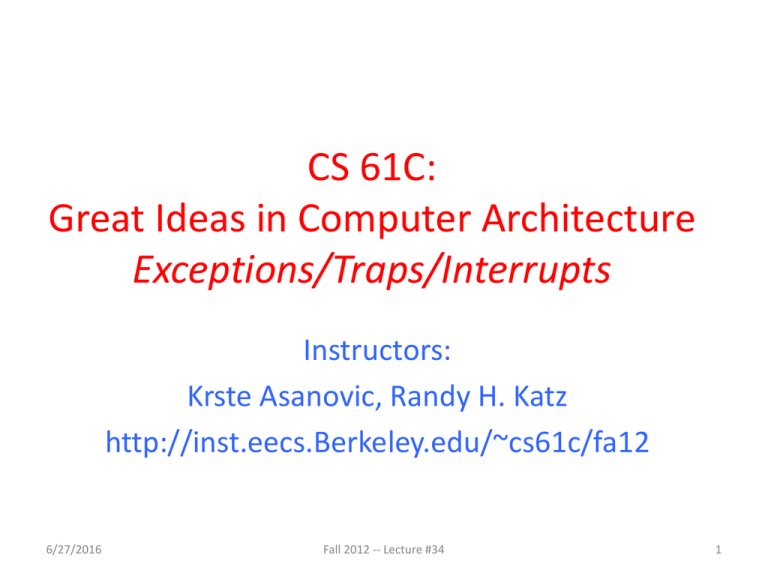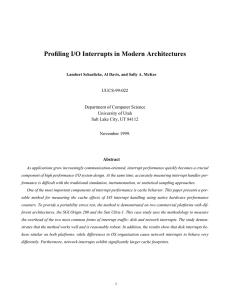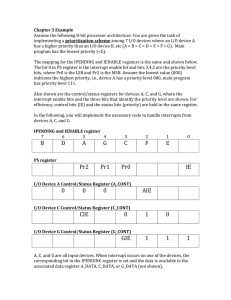CS 61C: Great Ideas in Computer Architecture Exceptions/Traps/Interrupts Instructors:
advertisement

CS 61C: Great Ideas in Computer Architecture Exceptions/Traps/Interrupts Instructors: Krste Asanovic, Randy H. Katz http://inst.eecs.Berkeley.edu/~cs61c/fa12 6/27/2016 Fall 2012 -- Lecture #34 1 Review • Great Idea: Redundancy to Get Dependability – Spatial (extra hardware) and Temporal (retry if error) • Reliability: MTTF & Annualized Failure Rate (AFR) • Availability: % uptime (MTTF-MTTR/MTTF) • Memory – Hamming distance 2: Parity for Single Error Detect – Hamming distance 3: Single Error Correction Code + encode bit position of error – Hamming distance 4: SEC/Double Error Detection • CRC for many bit detection, Reed Solomon per disk sector for many bit error detection/correction 4/12/11 Fall 2012 -- Lecture #33 2 You Are Here! Software • Parallel Requests Assigned to computer e.g., Search “Katz” Hardware Smart Phone Warehouse Scale Computer Harness • Parallel Threads Parallelism & Today’s Assigned to core Achieve High Lecture e.g., Lookup, Ads Computer Performance • Parallel Instructions >1 instruction @ one time e.g., 5 pipelined instructions • Parallel Data >1 data item @ one time e.g., Add of 4 pairs of words • Hardware descriptions All gates @ one time Memory Core (Cache) Input/Output Instruction Unit(s) Core Functional Unit(s) A0+B0 A1+B1 A2+B2 A3+B3 Main Memory Logic Gates • Programming Languages 6/27/2016 … Core Fall 2012 -- Lecture #34 3 I/O Hardware Memory Processor Enable? Read/Write Control Device Registers Datapath Address PC Registers Write Data Arithmetic & Logic Unit (ALU) Read Data Bytes Processor-Memory Interface 6/27/2016 Input/Outpu t Interface Fall 2012 -- Lecture #10 External Devices I/O-Memory Interfaces 4 Interfacing to I/O Devices • Programmed I/O – Software on CPU reads and writes to I/O device registers to explicitly transfer I/O data – Usually “memory-mapped” where device I/O registers are given memory addresses allowing regular load and store instructions to change register contents • Also possible to have special I/O instructions (x86, IBM mainframes) – Cheap but slow, burdens CPU • DMA (Direct Memory Access) – Extra hardware on device to autonomously transfer blocks of data into and out of memory – Expensive but fast, offloads CPU 6/27/2016 Fall 2012 -- Lecture #34 5 When to get I/O data? Most I/O devices are much slower than CPU • Polling – Software occasionally checks I/O devices to see if data ready – How often to poll? • Too often, waste CPU time • Too little, slow I/O – What if software forgets? • Interrupts – I/O device requests attention when something to do! 6/27/2016 Fall 2012 -- Lecture #34 6 I/O Hardware Interrupt Request Signal Memory Processor Enable? Read/Write Control Device Registers Datapath Address PC Registers Write Data Arithmetic & Logic Unit (ALU) Read Data Bytes Processor-Memory Interface 6/27/2016 Input/Outpu t Interface Fall 2012 -- Lecture #10 External Devices I/O-Memory Interfaces 7 Invoking the interrupt handler • An I/O device requests attention by asserting one of the prioritized interrupt request signals – Signals driven from external hardware • When the processor decides to process the interrupt – Stops the current program at instruction Ii, completing all the instructions up to Ii-1 – Saves the PC of instruction Ii in a special register • In MIPS, called EPC (Exception Program Counter) – Disables interrupts and transfers control to a designated interrupt handler, switching CPU to kernel mode • Most CPUs have a privileged execution mode to support operating systems, allowing software to do more than in regular user mode • After handling interrupt – Interrupt handler restores user program state and jumps back to current program in regular user mode using a special instruction • In MIPS, instruction is called RFE (Return From Exception) 8 Interrupts: altering the normal flow of control Ii-1 program HI1 Ii HI2 Ii+1 HIn interrupt handler An external or internal event that needs to be processed by another (system) program. The event is usually unexpected or rare from program’s point of view. 9 Types of Interrupts Interrupt: an event that requests the attention of the processor • Asynchronous: an external event – input/output device service-request – timer expiration – power disruptions, hardware failure • Synchronous: an internal event (a.k.a. traps or exceptions) – – – – undefined opcode, privileged instruction arithmetic overflow, FPU exception misaligned memory access virtual memory exceptions: page faults, TLB misses, protection violations – system calls, e.g., calling functions in operating system kernel 10 History of Exception Handling • First system with exceptions was Univac-I, 1951 – Arithmetic overflow would either • 1. trigger the execution a two-instruction fix-up routine at address 0, or • 2. at the programmer's option, cause the computer to stop – Later Univac 1103, 1955, modified to add external interrupts • Used to gather real-time wind tunnel data • First system with I/O interrupts was DYSEAC, 1954 – Had two program counters, and I/O signal caused switch between two PCs – Also, first system with DMA (direct memory access by I/O device) [Courtesy Mark Smotherman] 11 DYSEAC, first mobile computer! • Carried in two tractor trailers, 12 tons + 8 tons • Built for US Army Signal Corps [Courtesy Mark Smotherman] 12 Interrupt Handler (software inside operating system) • Saves EPC before enabling interrupts to allow nested interrupts – need an instruction to move EPC into GPRs – need a way to mask further interrupts at least until EPC can be saved • Needs to read a status register that indicates the cause of the interrupt • Uses a special indirect jump instruction RFE (returnfrom-exception) which – enables interrupts – restores the processor to the user mode – restores hardware status and control state 13 Administrivia • Project 3 regrade requests – DON’T EMAIL INSTRUCTORS – Email proj3.1regrade@gmail.com or proj3.2regrade@gmail.com – See Piazza posting for more details 6/27/2016 Fall 2012 -- Lecture #34 14 CS61C in the News: Intel 4004, 41 years old yesterday • First microprocessor • 4-bit accumulator architecture • 8mm pMOS • 2,300 transistors • 3 x 4 mm2 • 750kHz clock • 8-16 cycles/inst. 6/27/2016 Fall 2012 -- Lecture #34 15 CS61C In the News: “Texas Instruments Cuts 1,700 Jobs and Winds Down Tablet Chips”, NY Times 11/14/2012 “Texas Instruments is eliminating 1,700 jobs, as it winds down its mobile processor business to focus on chips for more profitable markets like cars and home appliances. Texas Instruments said in September it would halt costly investments in the increasingly competitive smartphone and tablet chip business, leading Wall Street to speculate that part of the company's processor unit, called OMAP, could be sold. The layoffs are equivalent to nearly 5 percent of the Austin, Texas-based company's global workforce. TI has been under pressure in mobile processors, where it has lost ground to rival Qualcomm Inc. Leading smartphone makers Apple Inc and Samsung Electronics Co Ltd have been developing their own chips instead of buying them from suppliers like TI. Instead of competing in phones and tablets, TI wants to sell its OMAP processors in markets that require less investment, like industrial clients like carmakers. TI is expected to continue selling existing tablet and phone processors for products like Amazon.Com Inc's Kindle tablets for as long as demand remains, but stop developing new chips.” [Rumors of Amazon being interested in buying this OMAP unit from TI ] 6/27/2016 Fall 2012 -- Lecture #34 16 Precise Interrupts • Interrupt handler’s view of machine state is that every instruction prior to the interrupted one has completed, and no instruction after the interrupt has executed. – Instruction taking interrupt might have written some special state but can be restarted. • Implies that handler can return from interrupt by restoring user registers and jumping to EPC – Software doesn’t need to understand the pipeline of the machine! • Providing precise interrupts is tricky in a pipelined superscalar out-of-order processor! – But handling imprecise interrupts in software is even worse. 6/27/2016 Fall 2012 -- Lecture #34 17 Synchronous Trap • A synchronous trap is caused by a particular instruction – E.g., system call, virtual memory page fault, unimplemented instruction, misaligned memory address • In general, the instruction cannot be completed and needs to be restarted after the trap has been handled – requires undoing the effect of one or more partially executed instructions • In the case of a system call trap, the instruction is considered to have been completed – a special jump instruction involving a change to privileged kernel mode 18 Exception Handling 5-Stage Pipeline PC Inst. Mem PC address Exception D Decode E Illegal Opcode + M Overflow Data Mem W Data address Exceptions Asynchronous Interrupts • How to handle multiple simultaneous exceptions in different pipeline stages? • How and where to handle external asynchronous interrupts? 19 Exception Handling 5-Stage Pipeline Commit Point Inst. Mem PC address Exception Select Handler PC Kill F Stage D Decode E Illegal Opcode + M Overflow Data Mem Data address Exceptions W EPC Cause PC Exc D Exc E Exc M PC D PC E PC M Asynchronous Kill Interrupts Writeback Kill D Stage Kill E Stage 20 Exception Handling 5-Stage Pipeline • Hold exception flags in pipeline until commit point (M stage) • Exceptions in earlier pipe stages override later exceptions for a given instruction • Inject external interrupts at commit point (override others) • If exception at commit: update Cause and EPC registers, kill all stages, inject handler PC into fetch stage 21 Speculating on Exceptions to avoid Control Hazard • Prediction mechanism – Exceptions are rare, so simply predicting no exceptions is very accurate! • Check prediction mechanism – Exceptions detected at end of instruction execution pipeline, special hardware for various exception types • Recovery mechanism – Only write architectural state at commit point, so can throw away partially executed instructions after exception – Launch exception handler after flushing pipeline • Bypassing allows use of uncommitted instruction results by following instructions 22 Exception Pipeline Diagram (I1) (I2) (I3) (I4) (I5) time t0 t1 t2 IF1 ID1 EX1 IF2 ID2 IF3 096: ADD 100: XOR 104: SUB 108: ADD Exc. Handler code Resource Usage IF ID EX MA WB time t0 t1 I1 I2 I1 t2 I3 I2 I1 t3 MA1 EX2 ID3 IF4 t4 IF5 t5 t6 t7 . . . . overflow! t3 I4 I3 I2 I1 t4 I5 - t5 t6 t7 .... I5 - I5 - I5 - I5 ID5 EX5 MA5 WB5 23 Summary • Asynchronous interrupts versus synchronous traps • Precise interrupts simplify software view of interrupted state • Handling exceptions is one of the most difficult parts of processor design, even though they occur infrequently – Separate “commit” from execute in design 6/27/2016 Fall 2012 -- Lecture #34 24 Acknowledgements • These slides contain material developed and copyright by: – Arvind (MIT) – Krste Asanovic (MIT/UCB) – James Hoe (CMU) • MIT material derived from course 6.823 • UCB material derived from course CS252 25




